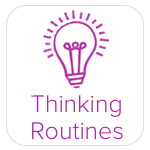- STEP 1: Ask students to gather together and give them a setting or a specific context, such as a rainforest, a winter market, or a protest rally. As a group, discuss what sounds we might hear in that setting or context.
- STEP 2: After brainstorming some ideas, ask students to demonstrate some ways to make these sounds using body percussion or their voices. For example, thunder could be made by stomping feet, while gentle rain could be made with finger snaps. Practice these sounds in isolation as a group.
- STEP 3: Explain that conductors often use hand signals as a cue for musicians or actors to get louder or softer. Practice together with the teacher as conductor. Put each sound in order. The whole group performs the sounds in order, with the teacher conductor either raising his/her hands for crescendo (getting louder), decrescendo (getting softer), or stop.
- STEP 4: Build a soundscape. Assign small groups to each sound and then slowly layer and build the sounds together, with the teacher signaling for each group to come in, get louder, get softer, fade out, and then stop. Reflect on how the soundscape represented the story, setting, or context.
- STEP 5: Repeat Step 4, but have a different student conductor lead the soundscapes each time. Consider how the conductor shapes the soundscapes and makes it slightly different.
 |  |  |
